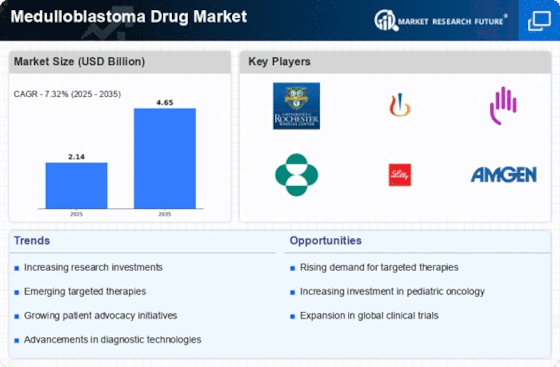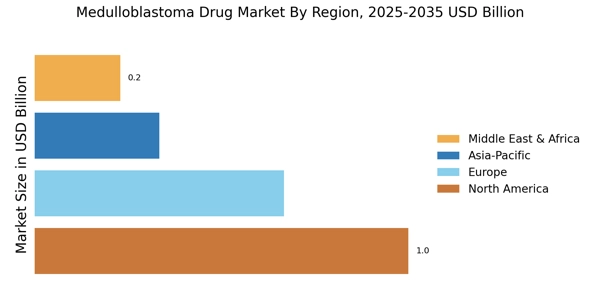Advancements in Precision Medicine
The Medulloblastoma Drug Market is experiencing a notable shift towards precision medicine, which tailors treatment based on individual genetic profiles. This approach enhances the efficacy of therapies, as it allows for the identification of specific molecular targets within tumors. Recent studies indicate that targeted therapies have improved survival rates in pediatric patients with medulloblastoma, leading to a growing demand for drugs that align with this trend. As a result, pharmaceutical companies are investing heavily in research and development to create innovative treatments that cater to these personalized approaches. The increasing understanding of the genetic underpinnings of medulloblastoma is likely to drive the market further, as more effective and less toxic treatment options become available.
Emergence of Combination Therapies
The Medulloblastoma Drug Market is witnessing a trend towards the use of combination therapies, which may enhance treatment efficacy and reduce the likelihood of resistance. Recent clinical trials have indicated that combining traditional chemotherapy with novel agents, such as targeted therapies and immunotherapies, can lead to improved outcomes for patients with medulloblastoma. This approach not only addresses the complexity of the disease but also aligns with the growing understanding of tumor biology. As more research supports the effectiveness of combination strategies, pharmaceutical companies are likely to invest in developing multi-modal treatment regimens. This trend could significantly reshape the therapeutic landscape within the Medulloblastoma Drug Market, offering new hope for patients and their families.
Growing Incidence of Medulloblastoma
The Medulloblastoma Drug Market is influenced by the rising incidence of medulloblastoma, particularly among children. Epidemiological data suggests that the annual incidence rate of medulloblastoma is approximately 5 cases per million children, which translates to a significant number of new patients each year. This increasing prevalence necessitates the development of new therapeutic options, thereby propelling market growth. Additionally, heightened awareness among healthcare professionals and parents regarding the symptoms and treatment options for medulloblastoma is likely to contribute to earlier diagnosis and intervention. Consequently, this trend may lead to an expanded patient population seeking effective treatments, further stimulating the demand within the Medulloblastoma Drug Market.
Increased Investment in Pediatric Oncology
The Medulloblastoma Drug Market is experiencing a surge in investment directed towards pediatric oncology. This trend is driven by a growing recognition of the unique challenges faced by children with cancer, including the need for therapies that minimize long-term side effects. Venture capital and philanthropic organizations are increasingly funding research initiatives aimed at developing new treatments for medulloblastoma. This influx of capital is expected to foster innovation and accelerate the development of effective drugs tailored for pediatric patients. Furthermore, collaborations between academic institutions and pharmaceutical companies are likely to enhance the research landscape, ultimately benefiting the Medulloblastoma Drug Market by bringing new therapies to market more rapidly.
Regulatory Support for Innovative Therapies
The Medulloblastoma Drug Market benefits from favorable regulatory environments that encourage the development of innovative therapies. Regulatory agencies are increasingly prioritizing expedited review processes for drugs targeting rare pediatric cancers, including medulloblastoma. Initiatives such as the Orphan Drug Act and Breakthrough Therapy Designation provide incentives for pharmaceutical companies to invest in research and development. This regulatory support not only accelerates the availability of new treatments but also enhances the attractiveness of the market for investors. As a result, the Medulloblastoma Drug Market is likely to witness a surge in novel drug approvals, which could significantly impact treatment paradigms and improve patient outcomes.


















Leave a Comment